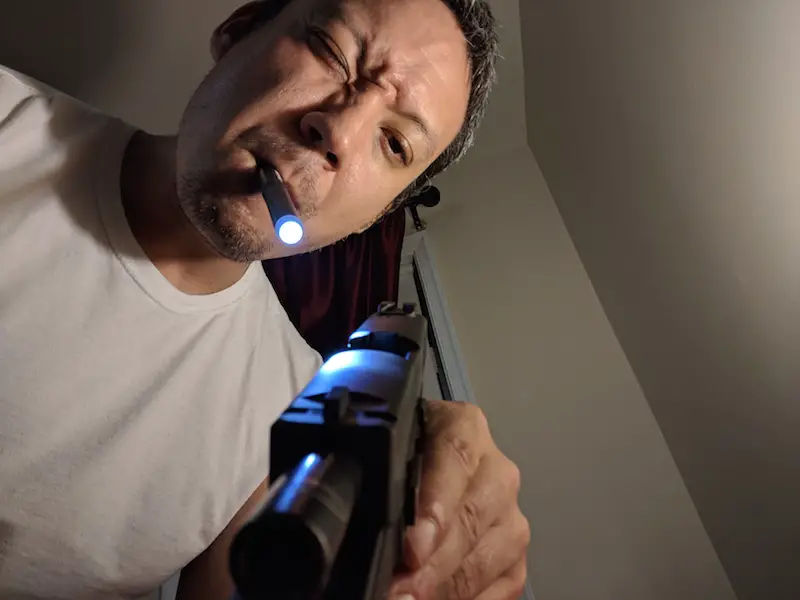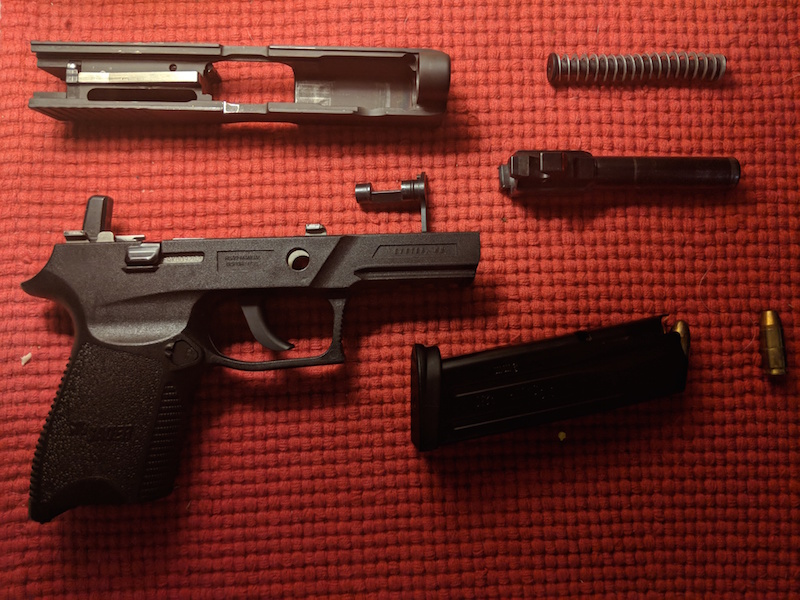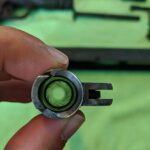The very first rule of handling a firearm is to always treat it as if it were loaded, and never point the muzzle at anything you aren’t willing to destroy. This includes your face! Every man, woman, and child is taught this philosophy from the very first moment they are introduced to guns. While this it is necessary to lay this foundation, it’s impractical to think that if you own a firearm you’ll completely avoid looking down the barrel of your gun.
Because of this, people often wonder, if it is safe to look down the barrel. And, if it is acceptable to look down the barrel, when is it ok? There are a few instances when it’s acceptable to look down the barrel. If you are competent with the firearm you are handling, you have cleared the weapon, and it has not left your possession, then it is safe to look down the barrel. Another instance when you can inspect the barrel is when the weapon is disassembled. This is the preferred method.
Next, we’ll discuss why it’s necessary to visually inspect your bore. We’ll also cover some alternatives to avoid looking down the barrel, and the safest ways to look down your barrel.
Table of Contents
When Looking Down The Barrel Is Necessary
Purchasing a firearm is no small investment. Beyond finding a trusted brand and model, you’ll likely inspect the weapon for any defects. This is particularly true of purchasing a used firearm. To my knowledge, every handgun comes from the factory having been fired at least once to show proper functioning. When I got my first 1911 I also received a casing from the first set of bullets that were fired through it. However, when buying a second-hand weapon from a dealer or private party, you really have no knowledge of the previous usage and care of that gun.
You’ll want to visually inspect the bore for any signs up buildup. Assuming that the weapon was well maintained, you should be able to use your thumbnail to redirect light down the barrel. This allows you to view from the proper end (the chamber). However, I also recommend checking from the other end of the barrel as well. Let’s discuss the best way to accomplish this.
Clearing The Weapon
I was taught from a young age, that when someone hands you a gun your first priority is to clear that weapon. This accomplishes three things. First, you can safely perform any number of activities, once the weapon is cleared. This includes things like field stripping the weapon, looking down the barrel, etc. Second, it proves you have the knowledge to handle that weapon and reinforces good habits (e.g. keeping the barrel pointed in a safe direction).
Finally, if you are unfamiliar with the pistol, whoever handed you the weapon should be able to demonstrate or walk you through clearing that weapon. If they are not able to satisfactorily accomplish this, then you should not look down the barrel. For the purposes of everyday carry, we’ll be discussing pistols. While there are other weapons, like rifles and shotguns, we won’t be covering how to clear those types of guns in detail.
Every weapon should be cleared by you personally. Clearing a weapon ensures that there is no cartridge in the chamber, and none available to be loaded into the weapon. Until you can validate that the weapon is cleared, you should assume it is loaded. I was taught that this was true, even if you see the person clear the weapon in front of you.
Clearing An Automatic
Alright, let’s discuss how you actually clear your weapon. First, we’ll cover how to accomplish this on an automatic.
- KEEP YOUR FINGER OFF THE TRIGGER!
- Remove the magazine
- Push the slide back
- Lock the slide in place
- Visually inspect the chamber from the rear of the weapon
Let’s cover each step a little more in detail. Removing the magazine first ensures that no additional rounds can be loaded into the chamber. When the slide is in the rear position, the cartridge in the chamber is ejected. When it moves forward, another round is chambered. By removing the magazine, the slide moving forward is unable to load another cartridge.
Once the magazine has been dropped, the remaining threat is any live round in the chamber. Move the slide to its rear position to eject any cartridge that might be chambered. I will then let the slide move to its forward position. I’ve found it is easier to do this than try to eject the round and lock the slide at the same time. Pull the slide back and lock its position.
Once complete, you can inspect the barrel from the rear of the weapon. At this point, the weapon should have no ammunition in it. At this point, assuming you’ve done this correctly, the gun is clear and any further actions can be taken. If the weapon leaves your hands, you should perform this action again.
Clearing A Revolver
The process for clearing a revolver varies slightly. However, the principles are the same.
- KEEP YOUR FINGER OFF THE TRIGGER!
- Press the release for the wheel
- Tilt the firearm rearward and press the ejector rod
- Inspect the barrel and wheel from the rear of the weapon
Because a revolver has different mechanical functions the process for clearing this type of handgun varies from that of an automatic. The wheel holds each round in a separate chamber. As the wheel rotates, another round is chambered.
Pressing the small button on the side of the firearm will release the wheel, allowing the entire structure to move laterally. You can apply gentle pressure to the side of the wheel so it moves outward.
Once this occurs, you have access to the ejector rod. Tilting the firearm rearwards allows the cartridges to fall freely into your hand when you press the ejector rod. This rod will extend out from the center of the wheel.
After you have emptied the cartridges, visually inspect the barrel and each chamber on the wheel. You should be able to see completely through the wheel at each chamber. Once this is complete the weapon can be considered cleared.
The Chamber
Whenever the need arises to visually inspect the barrel, before looking down the business end, it’s always best to exhaust all other options. The first step is to clear the weapon which we’ve already covered. After doing that, I recommend looking down the barrel from the chamber. You can use a mirror or your thumbnail to reflect light down the bore.
Another option is to use a telescoping camera and run that through the barrel. The Depstech Endoscope Borescope (Amazon link) is a good example. Not only are there various settings for resolution, but the LED lighting makes for clear image capture. Furthermore, it’s compatible with Android and iOS (Apple) operating systems.
Finally, and my preferred method of inspecting the barrel on my pistol is to field strip the weapon. Essentially, you’re taking the weapon apart and inspecting the bore while it’s free from the influence of the firing pin. Actually, at that point, it’s just a hollowed out metal rod. You can inspect to your hearts’ content without fear.
Parting Shots
I do not recommend looking down the barrel of a gun that is intact, because there are so many other ways to accomplish a barrel inspection. However, should the need arise, you can safely do this by clearing the weapon. Ensure that the weapon is not handled by someone else before using this method. Double, triple, and quadruple check that the weapon is cleared.
Ideally, you’ll have an intimate knowledge of your gun, including how to field strip and clean your weapon in order to inspect the bore. For those of you who carry a gun as part of your EDC kit, did I forget anything? Let me know your thoughts on this subject in the comments section.









